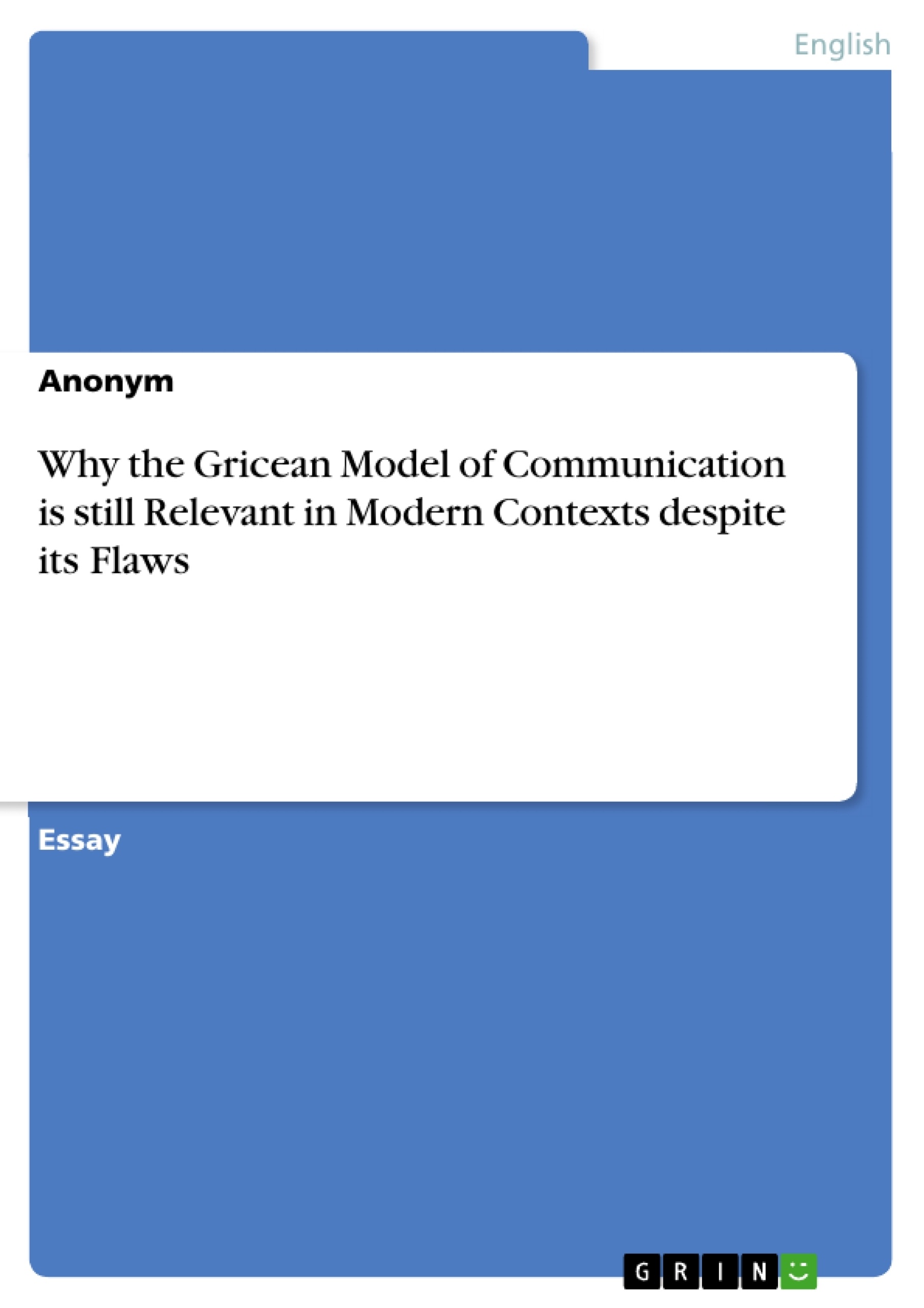This essay examines Paul Grice’s influential contributions to philosophy and linguistics, focusing on his Principle of Cooperation and theory of Implicatures within the Gricean Model of Communication. Through a practical example of miscommunication, the paper explores the definition of successful communication and the challenges inherent in interpreting speaker intentions. While highlighting the limitations and flaws of Grice’s model, such as its reliance on shared assumptions and context, the essay argues for its continued relevance in understanding and improving communication in contemporary society. By addressing both criticisms and strengths, the essay provides a balanced perspective on the applicability of Grice’s work in modern linguistic and social contexts.
Inhaltsverzeichnis (Table of Contents)
- Introduction
- About the Gricean Model of Communication
- Grice's Cooperative Principle and the Maxims of Conversation
- Implicatures
Zielsetzung und Themenschwerpunkte (Objectives and Key Themes)
This essay aims to analyze the Gricean Model of Communication, examining its strengths and weaknesses within modern communication contexts. It explores the relevance of Grice's work despite identified flaws.
- The Gricean Model of Communication and its core tenets.
- Analysis of the flaws within the Gricean Model.
- Examination of Grice's Cooperative Principle and Maxims of Conversation.
- Exploration of different types of implicatures.
- The continued relevance of the Gricean Model in contemporary communication.
Zusammenfassung der Kapitel (Chapter Summaries)
Introduction: This introductory section sets the stage by presenting a relatable scenario highlighting the complexities of communication and the potential for misinterpretations even when the speaker's intention is fulfilled. It introduces the central question of successful communication and its exploration through the lens of Paul Grice's influential work on the Gricean Model of Communication. The essay's purpose – to discuss the model's flaws while simultaneously demonstrating its enduring relevance in modern society – is clearly articulated.
About the Gricean Model of Communication: This section delves into the core of Grice's framework, distinguishing between literal and non-literal meaning. It emphasizes the crucial role of context and the interaction between speaker and hearer in shaping the meaning conveyed. Illustrative examples demonstrate how communicated meaning often extends beyond the literal interpretation of words, highlighting the concept of inferential processes in pragmatics. The discussion extends to the variability of word meaning based on context, using the word "fire" as a compelling example to show how context dramatically shifts interpretation and communicative effect.
Grice's Cooperative Principle and the Maxims of Conversation: This section lays out Grice's Cooperative Principle and its four categories of maxims (quality, quantity, relation, and manner). It explains how adhering to these maxims contributes to effective and efficient communication, emphasizing the principles of truthfulness, relevance, informativeness, and clarity. The section then explores various ways speakers can interact with these maxims: observing them, violating them, opting out of them (through hedges), and flouting them (for example, through irony or metaphor). The significance of hedges in politeness and in allowing for vagueness within communication is discussed.
Implicatures: This chapter introduces the concept of implicatures, focusing particularly on scalar implicatures, which arise from the Maxim of Quantity and involve the use of lower values on a scale to implicate the falsity of higher values. Examples like the ripeness of strawberries or the number of Kylie Jenner's cars illustrate how the selection of a lower value implies the rejection of higher values on a scale. The section also touches upon the distinction between conventional and conversational implicatures.
Schlüsselwörter (Keywords)
Gricean Model of Communication, Cooperative Principle, Maxims of Conversation, Implicatures, Literal Meaning, Non-Literal Meaning, Pragmatics, Conversational Implicature, Scalar Implicature, Politeness, Context, Communication.
Häufig gestellte Fragen
What is the main topic of the document?
The document provides a language preview focused on the Gricean Model of Communication.
What are the main objectives and themes discussed?
The essay aims to analyze the Gricean Model of Communication, examining its strengths and weaknesses in modern communication. Key themes include the core tenets of the model, its flaws, Grice's Cooperative Principle and Maxims of Conversation, types of implicatures, and the model's continued relevance.
What is the Gricean Model of Communication?
It is a framework that distinguishes between literal and non-literal meaning, emphasizing the role of context and interaction in shaping meaning beyond the literal interpretation of words.
What is the Cooperative Principle?
It is a principle outlined by Grice, which states that communication participants should make their conversational contribution such as is required, at the stage at which it occurs, by the accepted purpose or direction of the talk exchange in which you are engaged.
What are the Maxims of Conversation?
The Maxims of Conversation are guidelines that contribute to effective communication, falling under the categories of quality (truthfulness), quantity (informativeness), relation (relevance), and manner (clarity).
What are implicatures?
Implicatures are inferences that go beyond the literal meaning of an utterance. The document focuses on scalar implicatures, which arise from the Maxim of Quantity.
What are scalar implicatures?
Scalar implicatures involve the use of lower values on a scale to implicate the falsity of higher values. For example, saying "some" implies "not all."
What are some keywords associated with this document?
Keywords include Gricean Model of Communication, Cooperative Principle, Maxims of Conversation, Implicatures, Literal Meaning, Non-Literal Meaning, Pragmatics, Conversational Implicature, Scalar Implicature, Politeness, Context, and Communication.
What does the introduction section cover?
The introduction sets the stage by presenting a relatable scenario highlighting the complexities of communication and introduces the Gricean Model as a means of exploration.
What are the different ways a speaker can interact with the maxims?
Speakers can observe the maxims, violate them, opt out of them, or flout them.
- Quote paper
- Anonym (Author), 2020, Why the Gricean Model of Communication is still Relevant in Modern Contexts despite its Flaws, Munich, GRIN Verlag, https://www.grin.com/document/1516300




